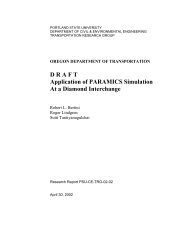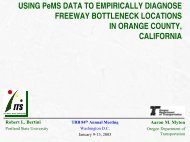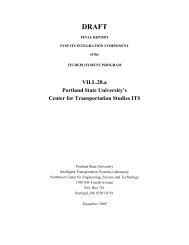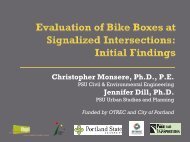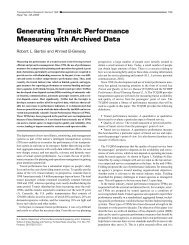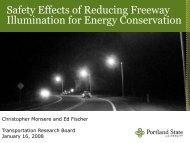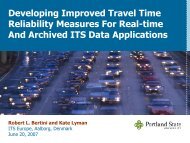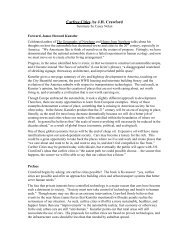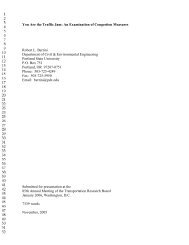Application of Paramics Simulation to a Diamond Interchange
Application of Paramics Simulation to a Diamond Interchange
Application of Paramics Simulation to a Diamond Interchange
Create successful ePaper yourself
Turn your PDF publications into a flip-book with our unique Google optimized e-Paper software.
<strong>Application</strong> <strong>of</strong> PARAMICS <strong>Simulation</strong> at a <strong>Diamond</strong> <strong>Interchange</strong> Page 14<br />
output. During the simulation, statistics such as <strong>to</strong>tal travel time, <strong>to</strong>tal distance traveled and<br />
average vehicle speeds can be written <strong>to</strong> data files and used <strong>to</strong> compare differences between<br />
each model run and also compared <strong>to</strong> field data.<br />
In general, the need for further calibration can be identified by comparisons between<br />
modeled and observed data that could include the following:<br />
• Traffic flows<br />
• Queue lengths (maximum and average) and s<strong>to</strong>p time<br />
• Delays (network wide and at individual junctions)<br />
• Traffic speeds<br />
• Traffic density<br />
• Travel times<br />
Quads<strong>to</strong>ne suggests that most networks can be sufficiently calibrated by adjusting the<br />
physical network <strong>to</strong> more closely resemble the actual streets and/or by making coding<br />
changes <strong>to</strong> links and nodes <strong>to</strong> permit vehicle movements like those observed on the actual<br />
street. (16) Commonly used calibration parameters include:<br />
• Including actual link gradients (all links are flat by default)<br />
• Inserting link instructions that either force merging or force “stay in lane” behavior<br />
that will override the PARAMICS lane changing model<br />
In the case <strong>of</strong> the Wilsonville Road study, a preliminary calibration was achieved by network<br />
alterations suggested by a comparison between modeled and observed travel times.<br />
Model Validation<br />
Validation is the process <strong>of</strong> determining whether the driver behavior models inherent in the<br />
s<strong>of</strong>tware package are producing results that match with observed driver behavior. In this<br />
study, model validation was accomplished with an empirical comparison <strong>of</strong> the results <strong>of</strong><br />
several simulation runs with behavior observed during several site visits and also using a<br />
comparison with generally expected driver behavior. Again, the on-line viewing <strong>of</strong> the<br />
simulation runs greatly enhanced the modeler’s ability <strong>to</strong> identify unexpected driver<br />
behavior.<br />
The overall behavior <strong>of</strong> the PARAMICS model can be changed considerably by modifying<br />
the “mean target headway” and “mean reaction time” or by altering the driver behavior<br />
“aggression” and “awareness” distributions. (4, 16) Alteration <strong>of</strong> these values based on<br />
model run comparisons <strong>to</strong> data sets collected on the actual network constitute a more<br />
rigorous model validation procedure.<br />
Quads<strong>to</strong>ne has set the PARAMICS mean headway and reaction times <strong>to</strong> default values <strong>of</strong> 1.0<br />
seconds based on speed and headway data extracted from loop detec<strong>to</strong>rs on freeways in the<br />
United Kingdom (16). For a small, suburban network like the Wilsonville road study area,<br />
these default values should suffice, since, with the exception <strong>of</strong> the ramp entrances <strong>to</strong> I-5,<br />
Portland State University Transportation Research Group 2002



